Combination lock

A combination lock is a type of locking device in which a sequence of symbols, usually numbers, is used to open the lock. The sequence may be entered using a single rotating dial which interacts with several discs or cams, by using a set of several rotating discs with inscribed symbols which directly interact with the locking mechanism, or through an electronic or mechanical keypad. Types range from inexpensive three-digit luggage locks to high-security safes. Unlike ordinary padlocks, combination locks do not use keys.
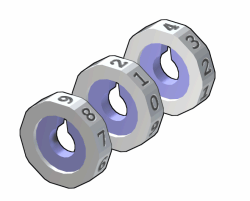

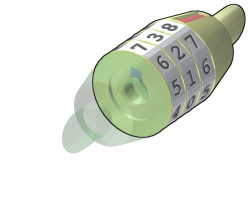
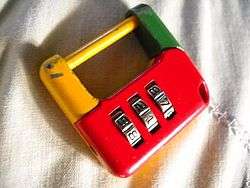
History
The earliest known combination lock was excavated in a Roman period tomb on the Kerameikos, Athens. Attached to a small box, it featured several dials instead of keyholes.[1] In 1206, the Muslim engineer Al-Jazari documented a combination lock in his book al-Ilm Wal-Amal al-Nafi Fi Sina'at al-Hiyal (The Book of Knowledge of Ingenious Mechanical Devices).[2] Muhammad al-Astrulabi (ca. 1200) also made combination locks, two of which are kept in Copenhagen and Boston Museums[3].
Gerolamo Cardano later described a combination lock in the 16th century.
In 1878 a German man by the name of Joseph Loch was said to have invented the modern combination lock for Tiffany's Jewelers in New York City, and from the 1870s to the early 1900s made many more improvements in the designs and functions of such locks.[4]
The first commercially-viable single-dial combination lock was patented on 1 February 1910 by John Junkunc, owner of American Lock Company. [5]
Types
Multiple-dial locks
One of the simplest types of combination lock, often seen in low-security bicycle locks and in briefcases, uses several rotating discs with notches cut into them. The lock is secured by a pin with several teeth on it which hook into the rotating discs. When the notches in the discs align with the teeth on the pin, the lock can be opened.
This lock is considered to be one of the least secure types of combination lock; many locks of this type can be quickly opened without knowledge of the correct combination. Opening one in this fashion depends on slight irregularities in the machining of the parts. Unless the lock is machined precisely, when the pin is pulled outward, one of the teeth will pull more strongly than the others on its corresponding disc. This disc is then rotated until a slight click is heard, indicating that the tooth has settled into the notch. The procedure is repeated for the remaining discs, resulting in an open lock, and a correct combination, in very little time.
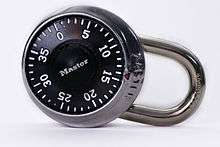
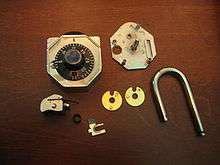
Single-dial locks
Combination locks found on padlocks, lockers, or safes may use a single dial which interacts with several parallel discs or cams. Customarily, a lock of this type is opened by rotating the dial clockwise to the first numeral, counterclockwise to the second, and so on in an alternating fashion until the last numeral is reached. The cams typically have an indentation or notch, and when the correct combination is entered, the notches align, allowing the latch to fit into them and open the lock.
Depending on the quality of the lock, some single-dial combination locks can also be defeated relatively easily. Typical padlocks are manufactured with generous tolerances, allowing two, three or even more digits of 'play' in the correct access sequence. Given a 60-number dial with three cams and three digits of play, the search space is reduced from 60 × 60 × 60 to 20 × 20 × 20, a 96% reduction in potential combinations.
Additionally, if testing the mechanism to open the lock does not modify the state of the lock, multiple combinations can be tried sequentially, drastically reducing the brute force search time. The first two digits are entered normally once, then, starting from the second digit, the dial is rotated sequentially through the digits, testing the lock on each. If it takes three seconds to input the first digit, two seconds for the second digit, and one second for the third digit, then the normal search time for a 60-number dial with three cams would be (3 + 2 + 1) × 60³. The reduced search time would be (3 + 2 + 60) × 60², a reduction of nearly 82% from 360 hours to 65 hours. This strategy can be extended to the second digit as well, slightly reducing the search time further.
When these two strategies are combined on a lock with the properties given above, the brute force search time is reduced by greater than 99%; a brute force search that would have taken 360 hours is reduced to an achievable 2.78 hours. This is still significantly better security than multiple-dial locks and many keyed locks, but unacceptable for high security applications.
Inexpensive padlocks are often also susceptible to direct mechanical attacks, such as the use of a padlock shim which can release the shackle without entering a combination. Early combination padlocks made by Master Lock could be cracked by pulling on the shackle of the lock and turning the dial until it stopped; each numeral in the combination could be revealed in this manner. More recent models of Master padlocks with a 40-position dial have a mechanical weakness that can give away the last numeral in the combination, and the first two numerals have a mathematical relationship with the last number. This weakness reduces the number of possible combinations from 64,000 to a mere 100, which can be tried in a very short time.
In 1978 a combination lock which could be set by the user to a sequence of his own choosing was invented by Andrew Elliot Rae. At this time the electronic keypad was invented and he was unable to get any manufacturers to back his mechanical lock for lockers, luggage, or brief-cases. The silicon chip locks never became popular due to the need for battery power to maintain their integrity. The patent expired and the original mechanical invention was instantly manufactured and sold worldwide mainly for luggage, lockers, and hotel safes. It is now a standard part of the luggage used by travellers.
Other designs
Many doors use combination locks which require the user to enter a numeric sequence on a keypad to gain entry. These special locks usually require the additional use of electronic circuitry, although purely mechanical keypad locks have been available since 1936.[6] The chief advantage of this system is that multiple persons can be granted access without having to supply an expensive physical key to each person. Also, in case the one of the keys is compromised, "changing" the lock requires only configuring a new key code and informing the users, which will generally be cheaper and quicker than the same process for traditional key locks.
Electronic combination locks, while generally safe from the attacks on their mechanical counterparts, suffer from their own set of flaws. If the arrangement of numbers is fixed, it is easy to determine the lock sequence by viewing several successful accesses. Similarly, the numbers in the combination (but not the actual sequence) may be determined by which keys show signs of recent use. More advanced electronic locks may scramble the numbers' locations randomly to prevent these attacks.
There is a variation of the traditional dial based combination lock wherein the "secret" is encoded in an electronic microcontroller. These are popular for safe and vault doors where tradition tends towards dial locks rather than keys. They allow many valid combinations, one per authorized user, so changing one person's access has no effect on other users. These locks often have auditing features, recording which combination is used at what time for every opening. Power for the lock may be provided by a battery or by a tiny generator set in operation by spinning the dial.[7][8]
Internal mechanisms
- A relock trigger, or internal relocker, is an integral part of the combination lock itself. It is usually designed to activate when the dial spindle is punched through. The trigger may consist of a spring-loaded lever or plunger that engages the bolt when the back cover is dislodged from the lock case. Some combination locks also are equipped with a thermal relock trigger that activates in the event of a torch attack. Nearly all safes made after World War II have relock triggers in their combination locks.
Inaccuracy of the name
Bobby Seagull has pointed out that, mathematically, the name "combination lock" is inaccurate, as a combination allows reordering of the elements. He suggests that a better name would be "permutation lock", since the order matters.[9] However, in a permutation, each element may only appear once. A more accurate description uses n-tuples, where n is the length of the "combinations" for the lock in question.
Alternatively, a combination lock can be seen as requiring knowledge both of the correct combination (in the mathematical sense), and the correct permutation of that combination.
Manufacturers
- ABUS
- Master Lock
- Sargent and Greenleaf
- Wordlock
- Dudley
- Conair
- Kaba Mas
References
- ↑ Hoepfner, Wolfram (1970). "Ein Kombinationsschloss aus dem Kerameikos". Archäologischer Anzeiger. 85 (2): 210–213
- ↑ Paul Vallely, How Islamic Inventors Changed the World, The Independent, 11 March 2006.
- ↑ Hill, D.R. (1998) Studies in medieval islmaic technology, Ashgate.
- ↑ "IMPROVEMENT IN TUMBLERS FOR PERMUTATION-LOCKS" by Joseph Loch, U.S. patent 200070, 5 Feb. 1878. Found in Google Books.
- ↑ "US948280.pdf" (PDF). docs.google.com. Retrieved 2017-04-15.
- ↑ U.S. Patent 2,029,080
- ↑ "Kaba-MAS X-09 and CDX-09 High Security Locks" (PDF). Dec 2010. p. 8.
- ↑ "Operating Instruction for the X-09 Type 1F High Security Electronic Lock" (PDF). December 2010. Archived from the original (PDF) on 28 July 2011.
- ↑ Solve a puzzle like a University Challenge star, BBC, 7 Aug 2017
External links
| Wikimedia Commons has media related to Combination locks. |
- How Combination Locks Work HowStuffWorks.com
- Wooden combination lock
- Locksoft glossary